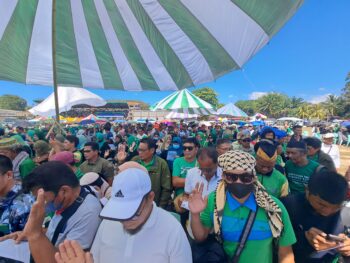MAKILALA, North Cotabato (MindaNews /19 November) – At the outdoor kitchen behind a government day care center at the Imelda Park in Magpet, North Cotabato, cook Grace Paclar sautes garlic for her menu of the day — chicken ginagmay (similar to menudo) — to feed 300 families in Barangay Tagbac while photojournalist Alex Baluyut beside her checks on his pork sinigang, the lunch he prepared for the other cooks and community volunteers.
It is Friday, November 15, 2019 and it is a special day for the Art Relief Mobile Kitchen (ARMK) as it marked its sixth anniversary in a most meaningful way: in a disaster site.
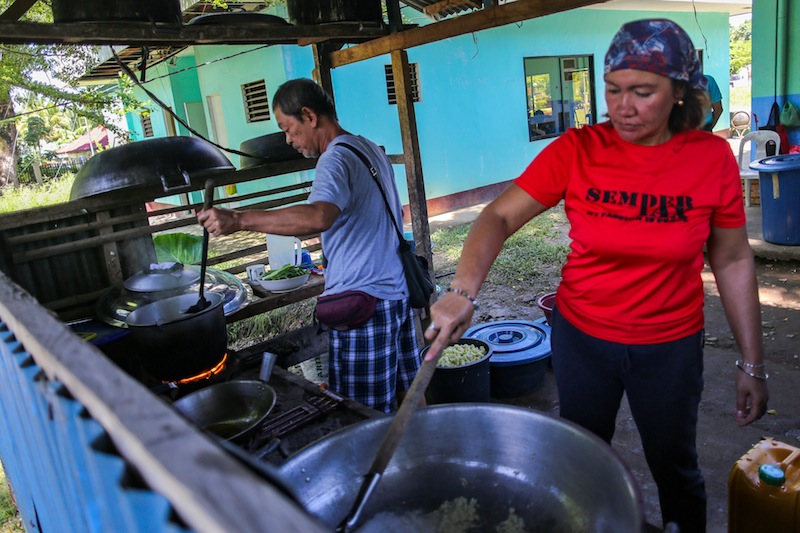 Art Relief Mobile Kitchen (ARMK) volunteer Grace Paclar (R) and head of mission Alex Baluyut (L) prepare meals in Magpet, North Cotabato on Friday, 15 November 2019. ARMK, a volunteer community kitchen, is cooking up hot meals for North Cotabato earthquake evacuees. MIndaNews photo by MANMAN DEJETO
Art Relief Mobile Kitchen (ARMK) volunteer Grace Paclar (R) and head of mission Alex Baluyut (L) prepare meals in Magpet, North Cotabato on Friday, 15 November 2019. ARMK, a volunteer community kitchen, is cooking up hot meals for North Cotabato earthquake evacuees. MIndaNews photo by MANMAN DEJETO
The disaster wrought by Yolanda (Halyan), the world’s most powerful typhoon in history to make landfall (on November 8, 2013) gave birth to the ARMK a week later, on November 15, 2013.
On that day, residents, rescuers, soldiers and other government workers flown in from the Yolanda-ravaged areas of Leyte and Samar to the Villamor Air Base in Metro Manila were welcomed by Baluyut, his wife Precious and other volunteers, with a bowl of hot arroz caldo.
From Villamor, they went to Tigbao, Tacloban to serve Christmas dinner to the Yolanda survivors, stayed 11 days in Tacloban and proceeded to Hernan in Samar for a week.
Since then, ARMK, which specializes on emergency food aid, has served not just arroz caldo but other hot meals to bakwits in practically all types of disasters: typhoons, floods, drought, fire and armed conflicts.
In Mindanao, ARMK was in the evacuation center in Tandag, Surigao del Sur in September 2015 following the killing of Emerito Samarca, Executive Director of the Alternative Learning Center for Agriculture and Livelihood Development (Alcadev) and two other companions.
It also provided food aid for drought victims of Arakan, North Cotabato in April 2016; in Iligan and Marawi cities during the Marawi Siege of 2017; in Jolo, Sulu following the fire that gutted down some 3,000 houses in the barangays of Lambayong, Busbus and Walled City on July 24, 2018; back in Jolo again in February 2019 after the January 27 bombing of the Our Lady of Mt. Carmel Cathedral that left 20 dead and a hundred others injured; and in quake-stricken North Cotabato since November 8.
Disasters in Mindanao are an occasion for reunions with other humanitarian workers. The likes of ARMK as well as Balay Mindanaw – both non-governmental organizations – are often seen in the underserved areas, in the peripheries where fewer relief goods and assistance reach the evacuees.
The Cagayan de Oro-based Balay Mindanaw provides tent materials and is serving 800 families in Barangay Manobo also in Magpet, and Barangay Santa Filomena in Makilala, and has been providing safe water to the ‘bakwits’ through its SkyHydrant which is capable of treating 10,000 liters of water a day, enough to serve 700 families.
ARMK serves the evacuees through its hot meals.
Doable and practical
Before Baluyut arrived in Magpet on November 10, ARMK volunteers from Madrid in Surigao del Sur, had proceeded to the area two days earlier, to cook hot meals.
Compared with other disaster sites, Magpet is the least problematic according to Baluyut, because the day care center has an outdoor kitchen for the children’s feeding, water is easily available, there is a dishwashing area and a clean restroom nearby, and a portion of the day care center was offered to serve as their sleeping quarters although some of them opted to sleep on the long dining tables at the kitchen area.
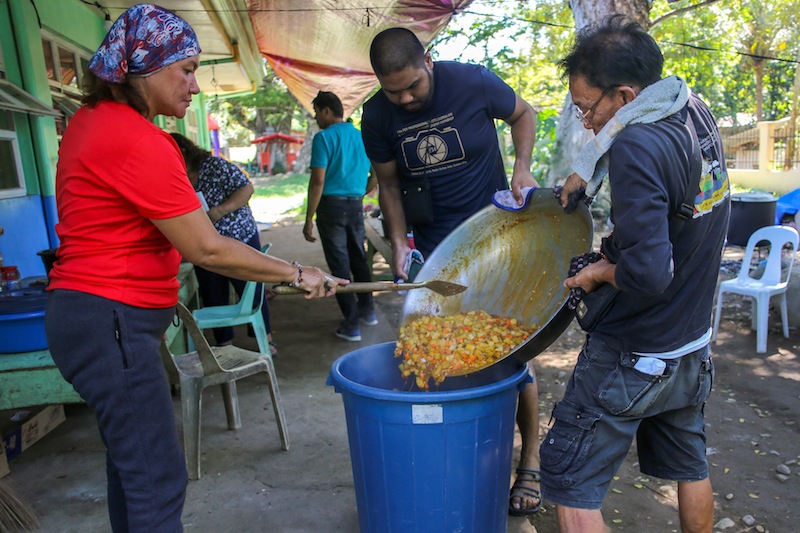 Art Relief Mobile Kitchen (ARMK) volunteers load the day’s meal – ginagmay which is similar to menudo – in Magpet, North Cotabato on Friday, 15 November 2019, bound for Barangay Tagbac evacuation camps. MindaNews photo by MANMAN DEJETO
Art Relief Mobile Kitchen (ARMK) volunteers load the day’s meal – ginagmay which is similar to menudo – in Magpet, North Cotabato on Friday, 15 November 2019, bound for Barangay Tagbac evacuation camps. MindaNews photo by MANMAN DEJETO
But whether or not there is an existing kitchen, the ARMK will find a way to set up one. Baluyut says the Villamor experience made him realize that a mobile kitchen or a guerilla kitchen “was actually doable and practical.”
ARMK feeds ‘bakwits’ one hot meal a day, usually early dinner, which they distribute mid-afternoon.
On this Friday afternoon in Magpet, the ARMK went to two evacuation camps in Barangay Tagbac – at the Tagbac Elementary School and Sitio Ambag of the same barangay.
“Di siya lutong preso ha” (This is not like prison food), Baluyut emphasized.
The chicken meat is cut into small portions (hence ginagmay) and mixed with carrots and sayote (in lieu of the very expensive potatoes). Grace says she does not use tomatoes or tomato sauce to ensure the food won’t spoil easily but she has found a way to make the food still as tasty.
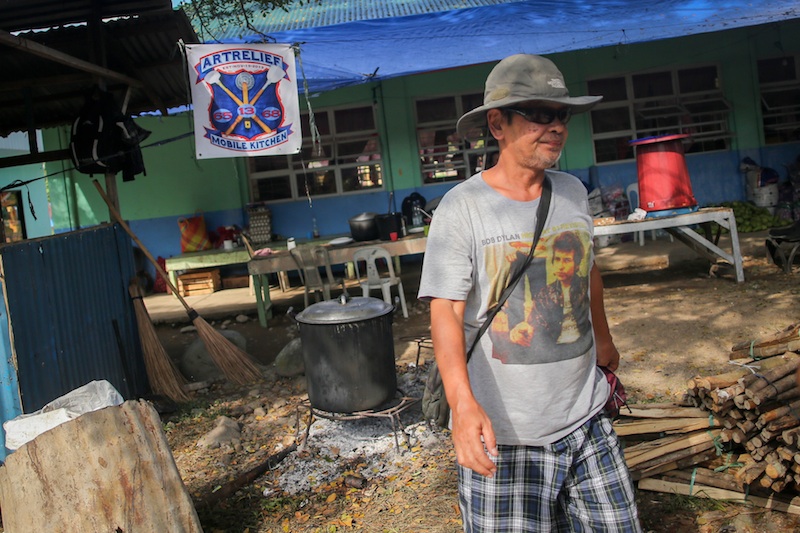 Photojournalist Alex Baluyut, founder of Art Relief Mobile Kitchen, in Magpet, North Cotabato on Friday, 15 November 2019. MindaNews photo by MANMAN DEJETO
Photojournalist Alex Baluyut, founder of Art Relief Mobile Kitchen, in Magpet, North Cotabato on Friday, 15 November 2019. MindaNews photo by MANMAN DEJETO
In Magpet, the community across the road from the day care center, has been the ARMK’s source of pork and chicken, as well as volunteers who help the cooks prepare the vegetables and meat, wash dishes, clean up the place, dispose of the trash, run errands and distribute the food.
As soon as the ARMK’s borrowed or rented vehicle arrives in the evacuation camp, evacuees approach the vehicle bringing their own plates or bowls. The ‘bakwits’ are then given hefty servings of chicken ginagmay and rice.
“Lami” (delicious), the ‘bakwits’ who returned to their tents to eat their early dinner, said.
Gina Ambag 42, mother of five, is grateful she does not have to cook dinner that day. They have been staying in the makeshift tent in the Tagbac Elementary School since October 31. She is anxious because “wala na mi ulian” (we don’t have a house to return to).
Ambag’s eldest child is 18 and in Senior High while the youngest, Elmer Kent, is turning a year old on November 24.
She narrated her house was still standing after the Magnitude 6.3 quake on October 16, that they started sleeping outside their house after the Magnitudes 6.6 and 6.1 quakes on October 29 as it was no longer safe inside and that the house eventually collapsed during the Magnitude 6.5 quake on October 31.
Comfort food
In an evacuation center where the usual relief goods handed to ‘bakwits’ are canned sardines, corned beef and noodles, a bowl or plate of cooked food is comforting, especially for those like Ambag.
The ARMK’s meal for the day varies. Today it is ginagmay, tomorrow it can be monggo served in yet another evacuation camp, or pinakbet, pancit, mixed vegetables, mochicken adobo or whatever food they can prepare from the donations received. They also cook arroz caldo and champorado.
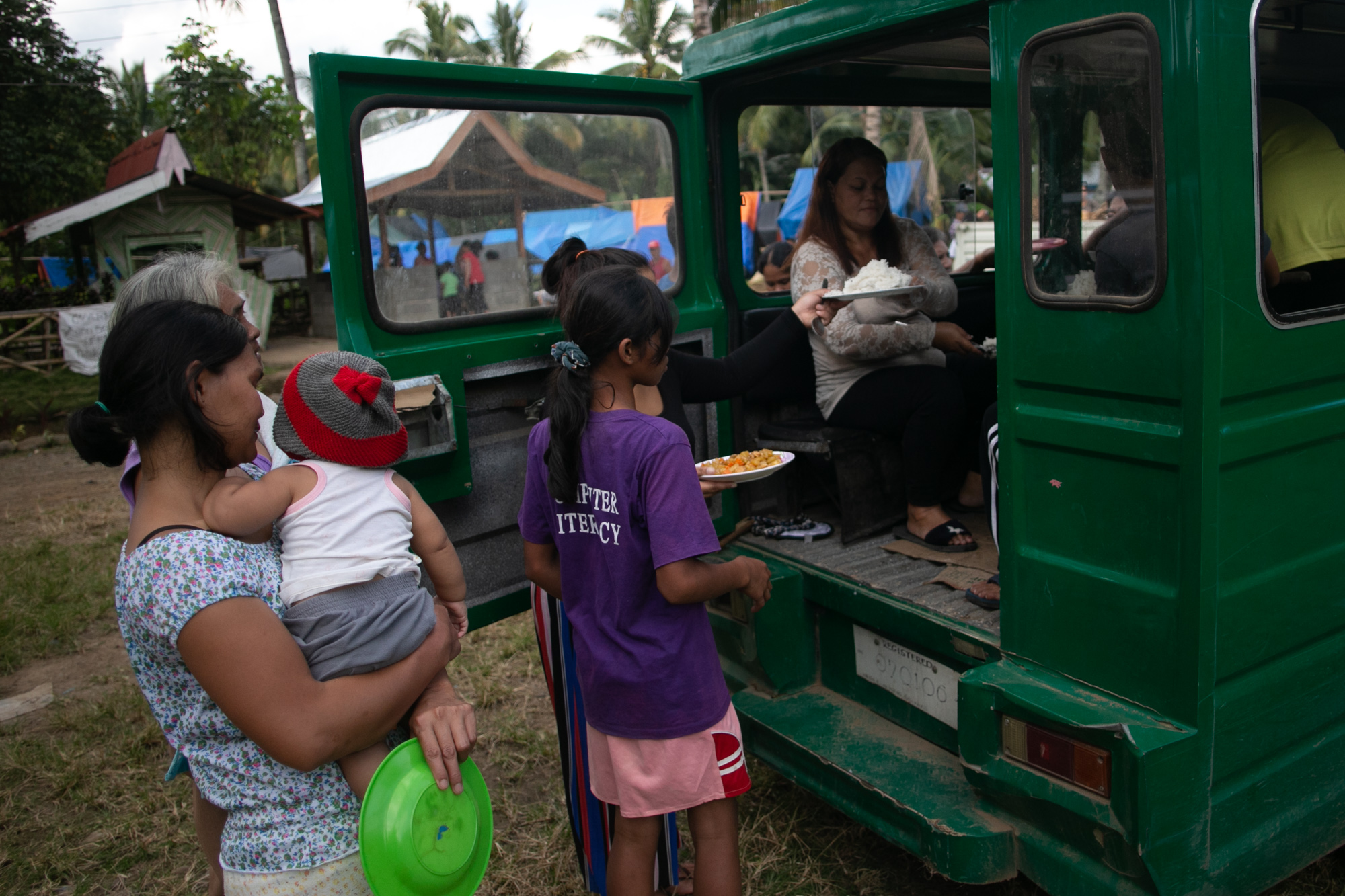 Evacuees from Barangay Tagbac in Magpet, North Cotabato receive free hot meal from Art Relief Mobile Kitchen (ARMK), a volunteer community kitchen that is cooking up hot meals for North Cotabato earthquake victims, on Friday, 15 November 2019. MindaNews photo by MANMAN DEJETO
Evacuees from Barangay Tagbac in Magpet, North Cotabato receive free hot meal from Art Relief Mobile Kitchen (ARMK), a volunteer community kitchen that is cooking up hot meals for North Cotabato earthquake victims, on Friday, 15 November 2019. MindaNews photo by MANMAN DEJETO
ARMK accepts donations in cash or in kind. Cash donations are used to purchase ingredients from residents nearby or the local market, fresh vegatables, huge pots and pans and woks if they can’t borrow from friends in the area, stove, gas for the stove, firewood, condiments, etc.
Cooked rice is served with viand to evacuees at Level 1 which Baluyut explains as residents who fled their villages with only the clothes on their back. Level 2 is when relief goods have reached the evacuees so ARMK serves only viand. Last Friday, they served both even as it was no longer Level 1, because they received a rice donation.
Ambag and her fellow evacuees said the cooked rice was delicious as well, apparently referring to the better rice variety used by ARMK.
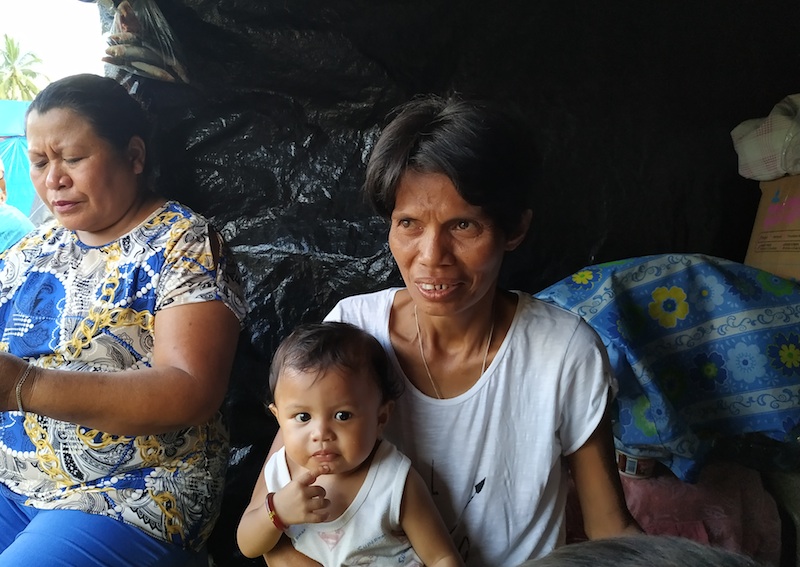 Gina Ambag, 42, mother of five, with youngest child Elmer Kent inside their tent in Tagbac Elementary School in Magpet, North Cotabato on 15 November 2019. Gina is anxious because they have no house to return to as it collapsed on October 31, 2019, during the Magnitude 6.5 quake, the fourth powerful quake above Magnitude 6 between October 16 and 31, 2019. MindaNews photo by CAROLYN O. ARGUILLAS
Gina Ambag, 42, mother of five, with youngest child Elmer Kent inside their tent in Tagbac Elementary School in Magpet, North Cotabato on 15 November 2019. Gina is anxious because they have no house to return to as it collapsed on October 31, 2019, during the Magnitude 6.5 quake, the fourth powerful quake above Magnitude 6 between October 16 and 31, 2019. MindaNews photo by CAROLYN O. ARGUILLAS
In Magpet, a farmer delivered string beans to the ARMK on horseback. The farmer returned on Friday to deliver two sacks of sayote.
Friends from Davao City sent vegetables and several dozens of eggs. Others volunteered to cook for a day or two, like Angely Chi of Swito Innovation Hub Coworking and Makerspace.
From Manila, Baluyut went to Iligan City to fetch Grace and Bobby Tambong whom he calls “war buddies” as they were the team in Marawi, Jolo, and now North Cotabato. From Iligan, they traveled overnight to reach Magpet.
Grace recalls they opted to sleep while traveling in the vehicle rather than spend money for a hotel stay. Besides, they wanted to save on time, too, as they were in a rush to reach Magpet.
Paclar is a member of the Kababayan Riders Association while Tambong is from the United Church of Christ in the Philippines. Both are based in Iligan.
Another volunteer who joined the team in Magpet is RA Valderrama, a photographer and a registered nurse.
The team plans on what meals to cook based on the inventory they have and based on the culture in the area.
During the Marawi Siege in 2017 where most of the 350,000 evacuees were Muslims, Baluyut said he made sure they bought new cooking pots and pans and even brought along the receipts to show Muslim leaders they had not been used. They served meals without pork, bought a lot of spices, including the ‘must have’ palapa, because Meranaws love spicy food.
Volunteers from the evacuees themselves have enabled ARMK to serve the cuisine of the displaced residents.
Baluyut, who has been to different places in the Philippines when he worked in wire agencies and newspapers, says he has learned so much about the types of cuisine from the evacuation sites they have been to in the last six years — from the north to the south, from Batanes to Sulu, from Luzon, Visayas and Mindanao.
Whenever possible, at the end of their stay in a disaster site, the ARMK leaves behind their pots and pans and whatever they can leave behind, for the community to use in both happy and sad events like fiestas, or to cook hot meals for evacuees near them.
In Magpet, Baluyut hoped they could borrow a freezer so they could serve a fish meal.
After Magpet, the ARMK moved to Kidapawan’s Barangay Perez to serve hot meals there, too, and was scheduled to proceed to Barangay Ilomavis at the foothills of Mt. Apo, on Wednesday.
Alex said his team will leave on Friday and are on stand-by for likely another mission to northern Luzon to serve hot meals to typhoon-stricken evacuees. (Carolyn O. Arguillas / MindaNews)
